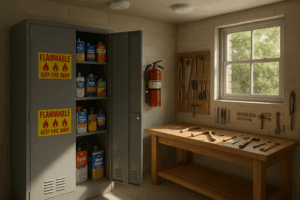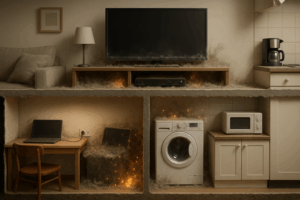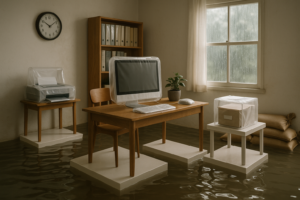Many homeowners worry about grease fires, faulty wiring, and unattended candles, but few pause to think about the growing layer of dust behind appliances or tucked away in attic corners. That powdery nuisance does not just cause sneezing, it can quietly create fire hazards throughout your household. This article uncovers how dust accumulation can spark home fires, why dust is so dangerous, where it lurks, and how you can take practical action to remove the risk. Your peace of mind begins with understanding the dangers hidden in plain sight.
Why Dust Buildup Raises Home Fire Risks
Dust seems harmless, but beneath the surface it harbors the materials needed to fuel dangerous fires. Every home produces dust, a fine blend of dead skin cells, pet dander, hair, fabric fibers, dirt, pollen, and sometimes metal or plastic fragments. The result is a powdery substance that easily collects in hidden areas, often left undisturbed for months or years.
Combustible dust becomes hazardous when it accumulates in quantities that can ignite. Dust easily catches fire because the particles have a large surface area exposed to air, making them easier to burn. When dust piles up around hot surfaces or inside electrical devices, it creates a path for heat transfer. A single spark, electrical arc, or overheating appliance can set these particles ablaze. If dust gets stirred into the air, it can even produce a combustible cloud, presenting the very real danger of flash fires or explosions if there is an ignition source nearby. The National Fire Protection Association cautions that even a thin layer of dust as small as 1/32 inch can fuel a serious fire. The unnerving reality is that many homes have far more dust than that hiding in overlooked spaces. (source)
The Science Behind Dust Explosions and Fire Spread
To understand why dust is a fire hazard, consider what happens when combustible particles mix with air. If disturbed by a sudden burst of wind, a broom, or a vacuum without a HEPA filter, dust quickly becomes airborne. Within this cloud, every tiny particle has access to oxygen, a key ingredient for fire. When this dust encounters a spark or the heat from an appliance, it can ignite instantly. The initial fire causes a rapid expansion of gases, potentially resulting in an explosion. These risks are not just limited to industrial spaces. Homes can experience a dangerous chain reaction if enough dust has settled in the wrong places.
Electrical appliances are especially prone to dust-related fires. When devices like computers, televisions, or heaters get clogged with dust, cooling fans cannot function efficiently, leading to overheating. Dust inside or behind an appliance adds another layer of fuel, so a small malfunction quickly escalates. Even simple wiring or extension cords hidden behind furniture can become covered in dust, turning minor electrical faults into disasters. Without regular cleaning and maintenance, these hazards often go unnoticed until it’s too late.
High-Risk Areas for Dust Accumulation at Home
Most people vacuum floors, wipe countertops, and dust shelves, but many never address the spaces where dust accumulates the most. These hidden zones are the perfect environments for dust to build up unchecked, raising fire hazards year after year.
Behind Appliances: Large kitchen and laundry appliances create a narrow gap between themselves and walls or cabinetry. These hard-to-reach spots attract dust from lint, flour, pet hair, and food crumbs. Since refrigerators, stoves, and dryers are heat-producing devices, a buildup of dry dust in these areas is especially dangerous.
Electronics: Devices like computers, televisions, game consoles, routers, and stereo equipment generate static electricity that pulls dust toward them. Retail gadgets are designed with cooling fans and vents that often get clogged, causing vital parts to overheat. Many households have junction boxes and surge protectors hidden behind entertainment centers, all collecting dust that blocks airflow and surrounds electrical connections.
Attics and Basements: These out-of-sight storage spaces are rarely cleaned. They host old boxes, insulation fibers, and forgotten fabrics, which create perfect hiding places for dense layers of dust. With little ventilation, these areas can have dust accumulating for years. Stored papers, cardboard, and even cluttered holiday decorations become a fuel source surrounded by a thick coating of dust.
HVAC Systems: Air ducts, furnace filters, and vent covers are often loaded with dust and debris. As your heating and cooling system operates, it circulates dust throughout the house, trapping some particles in filters but depositing others in hard-to-reach corners. A build-up inside ducts can even reduce the efficiency of your system, creating additional overheating risks if not addressed regularly.
Why Most Households Overlook These Risks
Modern homes are filled with comfort and convenience. Daily routines rarely include moving heavy appliances or crawling through attic crawlspaces. The hidden locations that collect dust are not on your weekly cleaning radar. Even conscientious homeowners focused on surface tidiness may miss the most dangerous pockets of buildup. The time and effort required for deep cleaning can convince even the most safety-minded families to put it off till another day.
Electronics and appliances often have warning labels about not blocking vents, yet most users do not check them for dust until the device malfunctions. Attics quickly become storage spaces for things seldom used, eliminating any reason to clear cobwebs or inspect for dust. Out of sight, out of mind, until a simple spark transforms invisible risks into irreversible loss. Breaking this pattern starts with new habits and practical routines focused on prevention rather than clean-up after the fact.
Dust as Fuel for Home Fires
When discussing fire hazards, dust deserves equal attention alongside traditional risks like open flames and faulty wiring. A buildup of household dust fuels a fire in several ways. Its fine particles ignite at much lower temperatures compared to larger debris. Once burning, dust helps flames jump from electrical devices to nearby fuels such as drapes, wood paneling, and even upholstered furniture.
The risk escalates if dust is allowed to collect in vents with poor airflow, such as a clogged dryer hose or blocked attic fan. These areas heat up rapidly during normal operation. Once a small blaze begins, airborne dust spreads combustion throughout the space, causing smoke and toxic fumes that endanger families long before flames become visible. Proper cleaning, storage, and maintenance starve potential fires of this fuel, making it much harder for accidents to ignite or spread unchecked.
Preventive Cleaning Strategies for Reducing Dust Hazards
Keeping dust at bay takes persistence, but the right cleaning methods make it manageable. Traditional brooms and dusters tend to stir up particles rather than collect them, creating clouds of hazardous dust in the air. For truly effective dust control, use microfiber cloths slightly dampened with water or a safe cleaning solution. These cloths grab and trap dust, preventing it from becoming airborne.
Vacuuming works for floors and under furniture, but only with units equipped with HEPA filters. HEPA filters capture the tiny combustible particles that other vacuums would blow back into the air. Avoid using compressed air for cleaning electronics or vents, as this method scatters dangerous dust clouds instead of removing them.
Schedule deep-cleaning sessions for high-risk areas once every few months. Move appliances away from walls and sweep or vacuum behind and beneath. Carefully unplug electronics before cleaning, then gently clean inside vents and cases with a soft brush or specialized vacuum designed for electronic devices. Use the cleaning recommendations provided by each manufacturer to avoid damaging sensitive equipment.
For attics and basements, remove stored items in batches. Wipe down surfaces before returning boxes to their place. Store loose items in sealed bins, not open cardboard, to keep dust from collecting. Regular rotation of stored items encourages ongoing cleaning instead of delayed, overwhelming deep cleans. A proactive approach reduces the total amount of dust that can collect. Keeping these areas tidy also reduces the likelihood of pests and mold, adding another layer of safety to your preventive routine.
Improving Ventilation to Reduce Dust Accumulation
Stagnant air creates the perfect conditions for dust to settle and stay. Increasing airflow in your home helps carry dust particles toward air filters instead of letting them pile up on surfaces. Simple steps such as opening windows for short periods, using exhaust fans in kitchens and bathrooms, and running ceiling fans all help to circulate air and dislodge resting dust. Well-placed ventilation prevents buildup in corners and hard-to-reach areas.
Your home’s heating and air conditioning system also plays a role in dust management. Regularly check and replace air filters according to their instructions. The filters should be inspected every month in homes with allergy or asthma sufferers, pets, or frequent foot traffic. Clean air ducts and return vents with a vacuum hose attachment every season to remove built-up dust and ensure air can move freely. If you notice excess dust in certain rooms or around vents, consider hiring a professional to inspect for obstructions, leaks, or mold that could be worsening your air quality. Regular HVAC maintenance reduces fire hazards while also improving indoor comfort.
Safe Appliance and Electronics Maintenance
Many fires traced to household dust begin as minor appliance malfunctions or overheating electronics. Preventative maintenance makes a huge difference. Set reminders to move major appliances once every season and clean behind them. Vacuum refrigerator coils to help prevent overheating. Lint traps and dryer vents require attention after every use, but the vent hose leading outside needs to be cleaned periodically to avoid dangerous lint and dust accumulations.
Inspect cords and connections on all electronics for signs of dust buildup, fraying, or discoloration. Dust that wraps around wires or plugs traps heat and increases risk. Unplug devices before cleaning, then wipe with a microfiber cloth, paying extra attention to vents and fans. Follow cleaning instructions from manufacturers, as excessive moisture can short circuit circuitry. Keep entertainment centers, desks, or media cabinets organized to lower the overall volume of dust. Avoid plugging too many devices into a single outlet, which can cause overheating, especially if surrounded by dust.
Managing Dust in Attics, Basements, and Storage
Attics and basements challenge even the most organized homeowners because they serve as catch-alls for seasonal and sentimental items. These spaces lack daily traffic, making dust accumulation even easier. For safe storage, use plastic bins with tight lids to contain clothes, linens, papers, and small items. Cardboard boxes and open shelves do little to keep dust out and tend to soak up moisture, creating another hazard as dust and dampness mix.
Sorting and removing unused items not only makes these spaces easier to clean, but also decreases the number of surfaces that can collect dust. Once a season, dedicate time to wipe down rafters, beams, and window sills. A shop vacuum fitted with a HEPA filter offers a fast way to remove loose debris and fine dust from unfinished floors or joist spaces. Old insulation or exposed storage sometimes harbors more dust than you might expect. Wear a dust mask when cleaning and use portable air purifiers if available, especially when disturbing settled dust. Routine maintenance means less work each time and a safer storage space all year long.
Control Ignition Hazards Near Dust-Prone Spaces
Cleaning is only part of the solution. Ignition sources must be kept separate from dusty areas to reduce fire risk. Avoid installing electrical outlets immediately behind heavy appliances or inside cluttered closets, especially in older homes where wiring might be outdated. Do not leave portable heaters, irons, or kitchen gadgets plugged in and unattended near surfaces that collect dust. Check regularly for frayed power cords or faulty plugs, as sparks from these can ignite surrounding particles faster than you may expect.
Extension cords and power strips should be cleared of dust and kept on open, ventilated surfaces. Never allow cords to become tangled or pressed under carpets, where dust and heat can build up. Hairdryers, portable fans, and space heaters deserve regular cleaning as well. Manufacturers often provide maintenance instructions to help you safely remove dust without damaging internal parts.
A professional safety inspection once a year can reveal forgotten hazards. Electricians and licensed home inspectors pinpoint outdated wiring, overloaded circuits, or hidden fire risks often missed during routine cleaning. Prevention depends on both removing dust and keeping it safely separated from anything that could spark a fire.
How Pets, Fabrics, and Furniture Contribute to Dust Fire Hazards
Every pet in the household means more hair, dander, and dust. Upholstered couches, drapes, carpets, and even plush toys add fibers to the air. Over weeks, the smallest particles find their way into the nooks and crannies behind and beneath furniture, layering on a hidden bed of flammable material. Routine brushing of pets outside and regular vacuuming of soft surfaces reduces both airborne dust and settled debris.
Furniture with fabric skirts, thick padding, or deep-seated cushions traps particles, especially in rooms with low air circulation. Move these items away from walls and vacuum underneath and behind them. Enclose stored linens, seasonal clothing, or holiday decorations in sealed bags or bins. For families who smoke indoors, the fire risk multiplies, as stray ashes and embers can ignite household dust in an instant. Discourage indoor smoking to further reduce the risk of accidental ignition.
Long-Term Home Dust Prevention Tactics
Building safer habits makes a lasting difference. Remove shoes before entering to limit outdoor dirt. Use door mats at every entry, and clean or replace them often. Place air purifiers in high-traffic areas, choosing units that include HEPA filters capable of trapping fine dust. Repair leaky windows and doors to keep outside pollen and dirt from drifting in. Organize storage zones by using shelves and bins that keep items off the floor and away from walls. Label boxes so you do not have to shift everything around, which often stirs up old dust clouds.
Regularly inspect all living areas for signs of dust buildup, especially after renovations or home projects that produce extra debris. If allergies are a concern or if you have noticed increased indoor dust, consider scheduling a professional cleaning service, especially for air ducts and attic spaces. Local mold remediation and fire safety professionals provide valuable insight into best practices for deep-cleaning these forgotten areas. Their expertise can head off hazards before they become emergencies. For additional resources, visit the All Nation Restoration website for guidance from experienced professionals.
Act Now to Prevent Dust Fire Hazards
Treat household dust as more than an irritant. Every pile and coating of dust represents a hidden risk for fire and property loss. By tackling the hidden areas most likely to collect dust, practicing safe cleaning, and keeping ignition sources out of dust-prone spots, you make your home much safer. Remember to clean behind appliances, inside and around electronics, up in the attic, and deep into basements and storage spaces. Invest in HEPA filter-equipped vacuums, improve home ventilation, and develop a seasonal cleaning routine you can sustain.
Your family’s safety depends on recognizing the threat of dust fire hazard. Action now protects your home and your memories for years to come.







